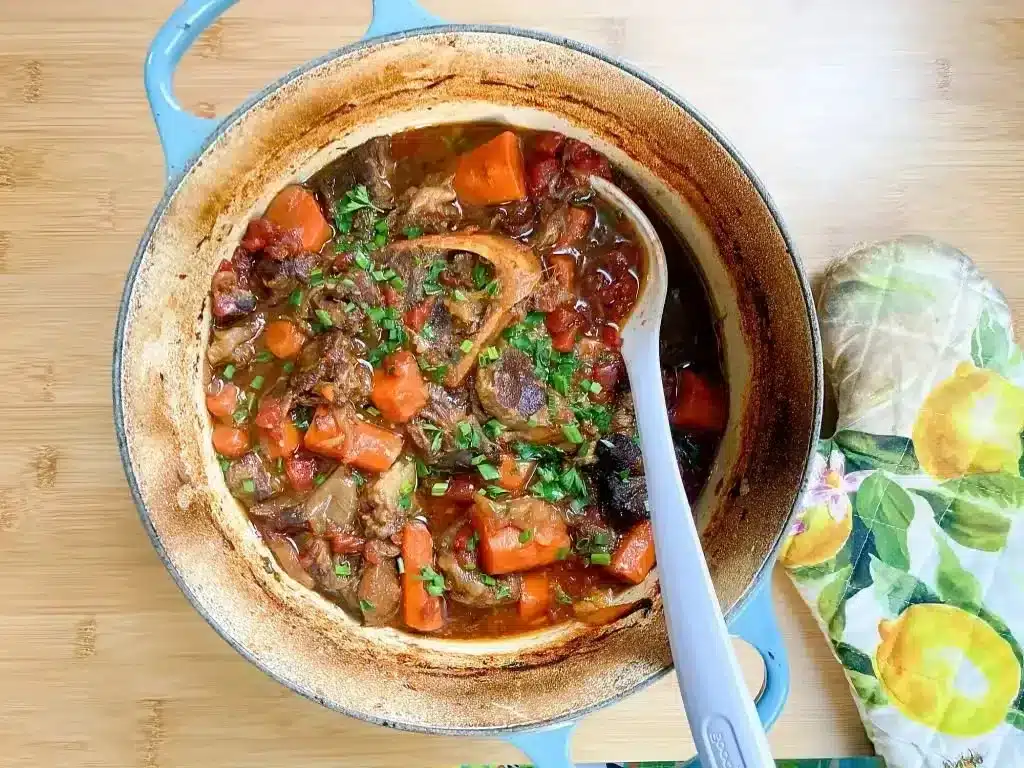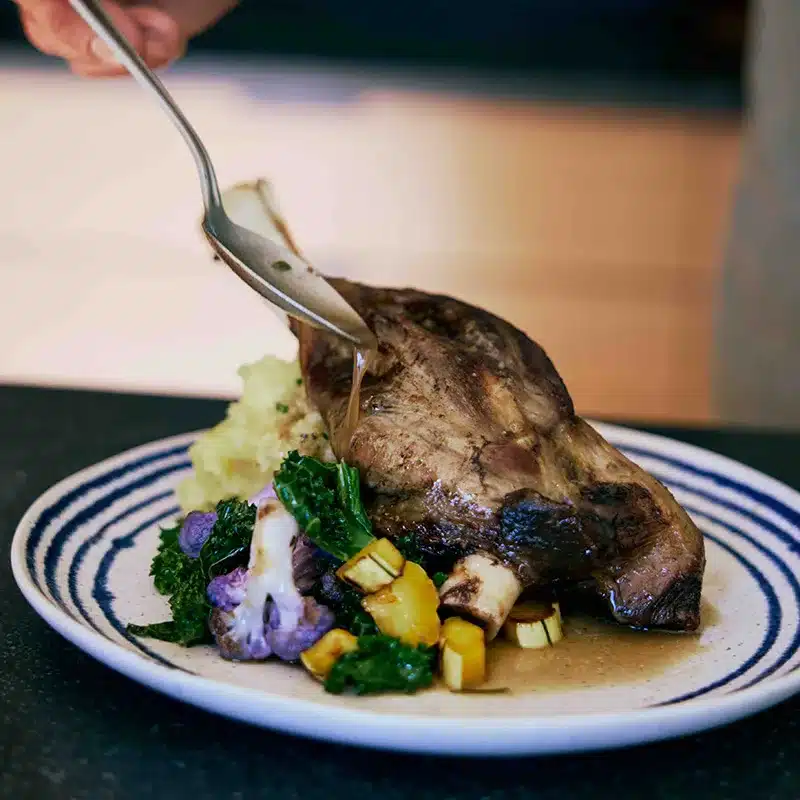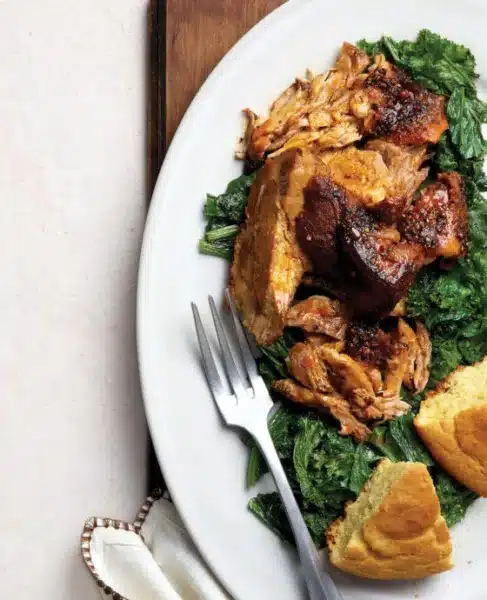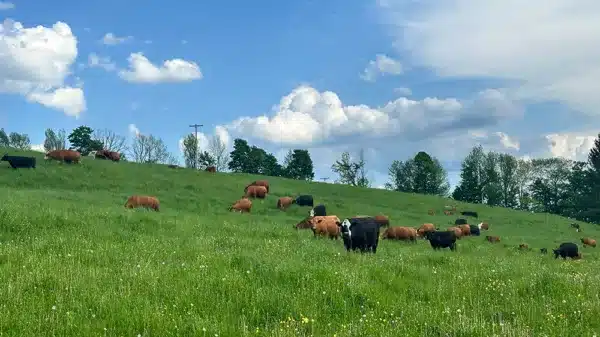Praise the Braise

Being a Walden member means supporting a system of agriculture where the farmer is not only paid a living wage, but they are also able to sell the whole animal they raise.
Because of our unique whole animal program, you as a member surely receive cuts that you are less familiar with. One cut we get many questions about is shank (both beef and lamb), so we wanted to take the opportunity to win you over to the pro shank party.
Tender. Flavorful. Easy.
Most of us are taught to believe that “tough” cuts of meat are less desirable than the most “tender” cuts, and yes, the pleasure of enjoying a well-cooked, delicious steak with loved ones is one reason we’re Walden members. But look outside that narrow category of the most tender cuts (which accounts for only 5-10% of the meat we get from a cattle and lamb), and your methods of cooking (and the meals you serve), will change for good.
Shanks come from the leg, a hard working group of muscles. That means they’re full of collagen that breaks down over time in low and slow cooking methods (like braising!). That collagen is full of a rich flavor that is especially unique and delicious coming from our grass-fed and finished beef and pastured lamb.
As one of our most under-appreciated cuts, we’ve been on a mission to educate our community about the merits of the earthy, complex flavors of this high quality cut of meat. You likely have everything you need in your pantry right now to start a hearty, nutritious meal that will come together easily and impress everyone. As for method – there are far more recipes out there for short ribs than shanks. Don’t let this stop you! You can use shanks in most recipes that call for braising bone-in short ribs?
At Walden, we are mostly fervent home cooks. We cook in ways that highlight the quality of the ingredients we source and welcome the challenges of working with cuts that are new to us. We experiment. We iterate – and we want to share the results with you, our members. We’re foodies, passionate about our environment, the people involved in changing our food system, and feeding our friends and families meals that nourish the soul. We thank you for being on this journey with us!
– All of us at Walden
Tangy Braised Shanks
This is the recipe that changed things for many of us at Walden. The original directions call for bone-in short ribs, but we’ve found this is equally, if not more, delicious when prepared with lamb shanks or marrow-rich beef shanks.
Ingredients
- 4 pounds bone-in Walden shanks (lamb or beef)
- Kosher salt and freshly ground black pepper
- 3 tablespoon vegetable or canola oil
- 2 large yellow onions, quartered
- 2 heads garlic, halved crosswise (papery skin may remain intact)
- 3 tablespoons honey
- ½ cup apple cider vinegar
- ½ cup soy sauce
- 4 cups beef broth
- 4 thyme sprigs
- 1 lemon, halved, for juicing
- Optional: add carrots or diced tomatoes to braising liquid before Step 6
Instructions
- Preparation: salt shanks for 1 hour at room temperature (or for more time in the fridge).
- Preheat oven to 300* F. Brown shanks (no need to cut into smaller pieces) in dutch oven or heavy pot over medium heat in 1 tablespoon of oil, ~5-7 minutes each size (working in batches). Remove meat from pot. Scrape out any charred pieces.
- Add 2 tablespoons of oil to pot. Add onion and garlic. Cook over medium-high heat until slightly browned, 4-5 minutes. Add honey and cook ~2-3 minutes, until it starts to bubble, scraping the bottom of the pot.
- Add soy sauce and apple cider vinegar. Simmer and reduce by about half, for ~5-8 minutes.
- Add broth and thyme and bring back to a simmer. Season with salt and pepper to taste, and add back in all meat (and any optional vegetables).
- Cover pot and place the oven for at least 3 hours. Leave alone in the oven for all three hours!
- Remove cover, increase oven temperature to 425* and let the meat brown for a bit, ~30-45 minutes.
- Squeeze lemon over shanks. Serve with rice, couscous, or quinoa.

Source: NYT Cooking
Related Posts

Slow-Roasted Pork Shoulder with Greens
Enjoy the first greens of the season with pasture-raised pork slow roasted for deep and delicious flavors

Our B Corp Recertification & Cultivating a Thriving Food System
This is about building something better—for the land, for farmers, for communities, and for the future.

Winter Pastures and Southern Wisdom
Change starts with the farmers. Those who wake up every day and choose to do things the right way, not the easy way.